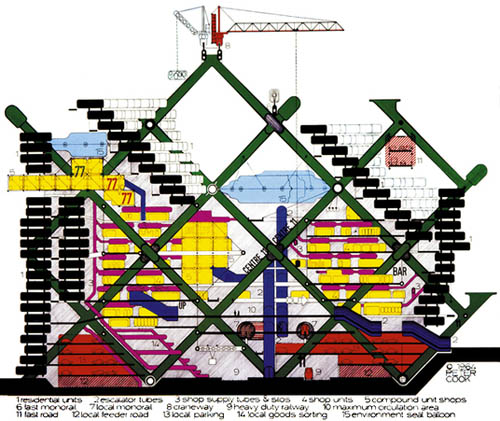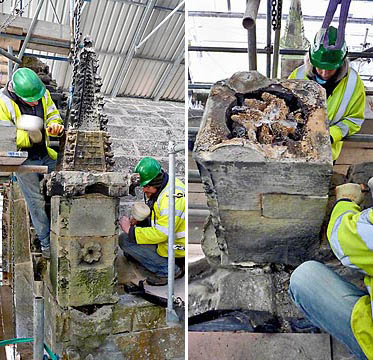BLDGBLOG (5)
By:
August 10, 2010
Concrete Honey and the Printing Room
 [Image: “Beamer Bees” by Liam Young and Anab Jain].
[Image: “Beamer Bees” by Liam Young and Anab Jain].
I had a long and interesting conversation last week with John Becker, one of my students at Columbia’s GSAPP, about everything from the future of 3D printers, the possibility of permanently embedding such machines into the fabric of a building, and even the genetic manipulation of nonhuman species so that they could produce new, architecturally useful materials.
A few quick things about that conversation seem worth repeating here:
1) Famously, groups like Archigram proposed using construction cranes as permanent parts of their buildings. The crane could thus lift new modular rooms into place, add whole new floors to the perpetually incomplete structure, and otherwise act as a kind of functional ornament. The crane, “now considered part of the architectural ensemble,” Archigram’s Mike Webb wrote, would simply be embedded there, “lifting up and moving building components so as to alter the plan configuration, or replacing parts that had work out with a ‘better’ product.”
 [Image: Plug-In City by Archigram/Warren Chalk, Peter Cook, Dennis Crompton; courtesy University of Westminster].
[Image: Plug-In City by Archigram/Warren Chalk, Peter Cook, Dennis Crompton; courtesy University of Westminster].
But 3D printers are the new cranes.
For instance, Enrico Dini’s sandstone-printing device — so interestingly profiled in Blueprint Magazine last month — could be installed somewhere at the heart of a building complex — or up on the roof, or ringed around the edge of a site — where it could left alone to print new rooms and corridors into existence, near-constantly, hooked up to massive piles of loose sand and liquid adhesives, creating infinite Knossic mazes. The building is never complete, because it’s always printing itself new rooms.
In fact, I think we’ll start to see more and more student projects featuring permanent 3D printers as part of the building envelope — and I can’t wait. A room inside your building that prints more rooms. It sounds awesome.
2) Several months ago, the Canadian Centre for Architecture, as part of their exhibition Actions: What You Can Do With the City, put up #77 in its list of things “you can do with the city”: they phrased it as Bees Make Concrete Honey.
My eyes practically fell out of my head when I saw that headline, imagining genetically modified bees that no longer produce honey, they produce concrete. They’d mix some strange new bio-aggregate inside their bellies. Instead of well-honeyed hives, you’d have apian knots of insectile concrete. Perhaps they could even print you readymade blocks of ornament: florid scrolls and gargoyle heads, printed into molds by a thousand bees buzzing full of concrete. Bee-printers.
Alas, it had nothing to do with apian concrete; it was simply a play on words: urban bees make urban honey… or concrete honey, if you want to be poetic. But no matter: using bees to create new forms of concrete — perhaps even new forms of sandstone (whole new geologies!) — is ethically horrific but absolutely extraordinary. After all, there are already bugs genetically modified to excrete oil, and even goats that have been made to produce spider silk.
What, though, are the architectural possibilities of concrete honey?
 [Images: The Rosslyn Chapel hives; photos courtesy of the Times].
[Images: The Rosslyn Chapel hives; photos courtesy of the Times].
3) Last month, over at Scotland’s Rosslyn Chapel, it was announced that “builders renovating the 600-year-old chapel have discovered two beehives carved within the stonework high on the pinnacles of the roof. They are thought to be the first man-made stone hives ever found.”
- It appears the hives were carved into the roof when the chapel was built, with the entrance for the bees formed, appropriately, through the centre of an intricately carved stone flower. The hives were found when builders were dismantling and rebuilding the pinnacles for the first time in centuries.
As the article goes on to point out, “Although human beings have collected honey from wild bee colonies since time immemorial, at some point they began to domesticate wild bees in artificial hives, made from hollow logs, pottery, or woven straw baskets. The Egyptians kept bees in cylindrical hives, and pictures in temples show workers blowing smoke into the hives, and removing honeycombs. Sealed pots of honey were found in Tutankhamun’s tomb.”
But, combining all these stories, what about bees that make concrete honey, artificially bred and housed inside hives in the spires of buildings? Hives that they themselves have printed?
High up on the roof of St. John the Divine sit six symmetrical stone hives, inside of which special bees now grow, tended by an architecture student at Columbia University; the bees are preparing their concrete to fix any flaw the building might have. No longer must you call in repair personnel to do the job; you simply tap the sides of your concrete-mixing beehives and living 3D printers fly out in a buzzing cloud, caulking broken arches and fixing the most delicate statuary.
Nearby homeowners occasionally find lumps of concrete on their rooftops and under the eaves, as if new hives are beginning to form.
4) In the opening image of this post, you see the so-called “Beamer Bees” that Liam Young, Anab Jain, and collaborators created for Power of 8. The beamer bees were “formulated by a community of biologists and hired bio-hackers to service under-pollinated trees, plants and vegetables due to the disappearance of honey bees.” And while the beamers don’t actually have much to do with the idea of mobile 3D-printing swarms, any post about designing with bees would be incomplete without them…
(Thanks to Steve Silberman for the Rosslyn Chapel hives link, and to John Becker for the conversation these ideas first came from).
We’ve described Geoff Manaugh’s BLDGBLOG “our favorite history/urban exploration/science fiction/design/climate change/city planning blog.” So we’re delighted to present a curated series of 10 BLDGBLOG posts. This is the series’ fifth installment.
